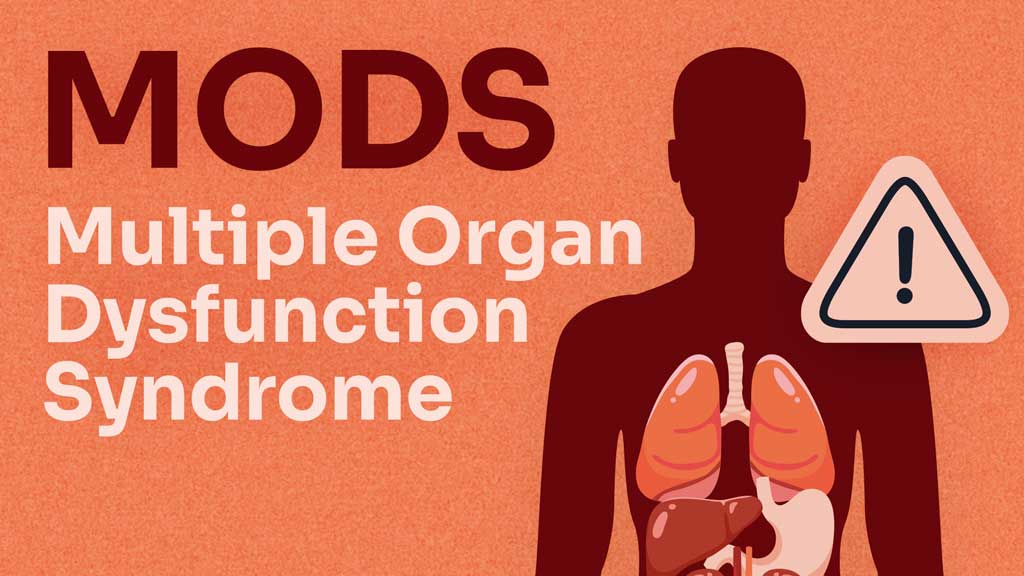Multiple organ dysfunction syndrome (MODS) carries a serious risk of mortality.
In order to prevent it from progressing to an irreversible stage, immediate detection and treatment are crucial (Procter 2024).
What is Multiple Organ Dysfunction Syndrome?
Multiple organ dysfunction syndrome (MODS) is defined as the progressive physiological dysfunction of two or more organs or organ systems where homeostasis cannot be maintained without intervention (Al-Khafaji 2024; Nickson 2020).
MODS is generally initiated by illness, injury or infection, causing a state of immunodepression and hypometabolism (Nickson 2020).
Rather than a single event, MODS is considered a continuum on which the extent of dysfunction can vary greatly, from mild impairment to irreversible failure (Al-Khafaji 2024).
Organs commonly affected by MODS include the heart, lungs, liver, kidneys, brain and blood (Cleveland Clinic 2023).
MODS is associated with significant mortality and morbidity, contributing to about 50% of deaths in intensive care units (Nickson 2020).
Causes of Multiple Organ Dysfunction Syndrome
MODS is induced by illness, injury or infection that triggers a systemic inflammatory response (known as systemic inflammatory response syndrome), resulting in tissue injury (Nickson 2020).
Potential causes include:
- Sepsis
- Major trauma
- Burns
- Pancreatitis
- Aspiration syndromes
- Blood transfusions
- Autoimmune disease
- Heat-related illness
- Eclampsia
- Poisons/toxins.
(Nickson 2020)

Risk Factors for Multiple Organ Dysfunction Syndrome
- An individual’s genetics may dictate the likelihood and severity of MODS following a trigger
- A patient with premorbid organ dysfunction may be prone to further deterioration
- Medications, therapies and ICU supports may contribute to organ injuries
- A patient with an infection is at risk of MODS.
(Nickson 2020)
How to Assess for Multiple Organ Dysfunction Syndrome
- Undertake a systems approach assessment (head-to-toe assessment).
- Document and analyse data from the patient’s vital signs, taking into account any trends.
- A SOFA score in relation to sepsis can be used in line with other assessment tools.
(Nickson 2020)
Presentation and Symptoms of Multiple Organ Dysfunction Syndrome
In order to be diagnosed with MODS, the patient should be experiencing dysfunction of at least two organs (this may be mild or severe) in addition to systemic inflammatory response syndrome (Nickson 2020).
Organ dysfunction may present as:
- Acute kidney injury (AKI) and uraemic acidosis
- Acute respiratory distress syndrome (ARDS)
- Cardiomyopathy
- Encephalopathy
- Gastrointestinal dysfunction
- Hepatic dysfunction
- Coagulopathy and bone marrow suppression
- Acute neurological dysfunction.
(Nickson 2020)
The patient may display some of the following symptoms, depending on which organs are affected:
- An altered mental state
- A decrease in renal perfusion (decrease in urine output)
- Respiratory deterioration
- A decrease in cardiac function/output (e.g. low blood pressure, arrhythmia)
- Deranged metabolic status
- A compromised fluid balance
- Pale, clammy, peripherally cool skin and faint pedal pulses.
(Procter 2024)
Systemic inflammatory response syndrome is defined as two or more of the following:
- Temperature > 38°C or < 36°C
- Heart rate > 90 beats per minute
- Respiratory rate > 20 breaths per minute OR arterial carbon dioxide tension (PaCO2) < 32 mm Hg
- Abnormal amount of white blood cells (> 12,000/µL, < 4,000/µL or > 10% immature [band] forms).
(Al-Khafaji 2025)
Treatment and Management of Multiple Organ Dysfunction Syndrome
MODS is difficult to treat, escalates quickly and is often fatal. Therefore, early detection is crucial in preventing its progression (Kandola 2023).
Positive patient outcomes rely on immediate recognition, ICU admission and invasive organ support (Gourd & Nikitas 2019). Management and treatment may include:
- Identifying and treating the underlying causes, comorbidities or complications
- Fluid resuscitation to increase perfusion
- Vasoactive medications to maintain adequate organ perfusion
- Antibiotics if sepsis is definite or probable
- Supportive care and monitoring:
- Multi-organ support
- Mechanical or non-invasive ventilation
- Maintaining fluid homeostasis
- Renal replacement therapy
- Nutrition
- Blood glucose control.
(Nickson 2020; Evans et al. 2021)
Preventing Multiple Organ Dysfunction Syndrome
As a complication of an illness, injury or infection, MODS is difficult to prevent. Early recognition improves patient outcomes - this is the only way to prevent damage.
It is important to monitor patients closely and administer appropriate therapies to facilitate organ function (Al-Khafaji 2024).
- Maintain an accurate fluid balance chart
- Support the haemodynamic needs of the patient (identify low blood pressure, analyse trends, escalate to the medical team and treat early)
- Identify any potential triggers of MODS
- Ensure regular blood tests are performed
- Decrease the risk of further organ damage if MODS is identified through early implementation of care.

Complications of Multiple Organ Dysfunction Syndrome
While MODS itself is the complication of an underlying condition, it represents a spectrum of dysfunction and can rapidly increase in severity (Wang et al. 2017).
In the later stages of MODS, the affected organs may completely lose function (multiple organ failure). This carries a mortality risk of up to 80 to 96% and may not be reversible. Therefore, preventing MODS from progressing into organ failure is crucial (Wang et al. 2017).
If the patient becomes increasingly unwell, they may require intensive care admission and aggressive treatment to maximise organ function.
Conclusion
MODS is a serious condition and can be life-threatening if not addressed early. If a patient presents with MODS, escalate care as necessary and support the affected organs.
Note: This article is intended as a refresher and should not replace best-practice care. Always refer to your facility's policy on preventing and responding to deterioration and multiple organ dysfunction syndrome.
Test Your Knowledge
Question 1 of 3
Multiple organ dysfunction syndrome is defined by the dysfunction of how many organ systems?
Topics
Further your knowledge
References
- Al-Khafaji, AH 2024, Multiple Organ Dysfunction Syndrome in Sepsis, Medscape, viewed 3 June 2025, https://emedicine.medscape.com/article/169640-ovsystemirview
- Al-Khafaji, AH 2025, Systemic Inflammatory Response Syndrome (SIRS), Medscape, viewed 3 June 2025, https://emedicine.medscape.com/article/168943-overview
- Cleveland Clinic 2023, Multiple Organ Dysfunction Syndrome, Cleveland Clinic, viewed 3 June 2025, https://my.clevelandclinic.org/health/diseases/multiple-organ-dysfunction-syndrome
- Evans, L, Rhodes, A, Alhazzani, W 2021, ‘Surviving Sepsis Campaign: International Guidelines for Management of Sepsis and Septic Shock 2021’, Critical Care Medicine, viewed 6 June 2025, https://journals.lww.com/ccmjournal/fulltext/2021/11000/surviving_sepsis_campaign__international.21.aspx
- Gourd, NM & Nikitas, N 2019, ‘Multiple Organ Dysfunction Syndrome’, Journal of Intensive Care Medicine, vol. 35, no. 12, viewed 3 June 2025, https://journals.sagepub.com/doi/abs/10.1177/0885066619871452
- Kandola, A 2023, ‘What to Know About Multiple Organ Dysfunction Syndrome’, Medical News Today, 30 January, viewed 3 June 2025, https://www.medicalnewstoday.com/articles/multiple-organ-dysfunction-syndrome
- Nickson, C 2020, Multiple Organ Dysfunction Syndrome, Life in the Fast Lane, viewed 3 June 2025, https://litfl.com/multiple-organ-dysfunction-syndrome/
- Procter, LD 2024, Shock, MSD Manual, viewed 3 June 2025, https://www.msdmanuals.com/home/heart-and-blood-vessel-disorders/low-blood-pressure-and-shock/shock
- Wang, Z et al. 2017, ‘Clinical Application of a Novel Diagnostic Scheme Including Pancreatic β‑cell Dysfunction for Traumatic Multiple Organ Dysfunction Syndrome’, Molecular Medicine Reports, vol. 17 no. 1, viewed 3 June 2025, https://www.spandidos-publications.com/10.3892/mmr.2017.7898
 New
New 

